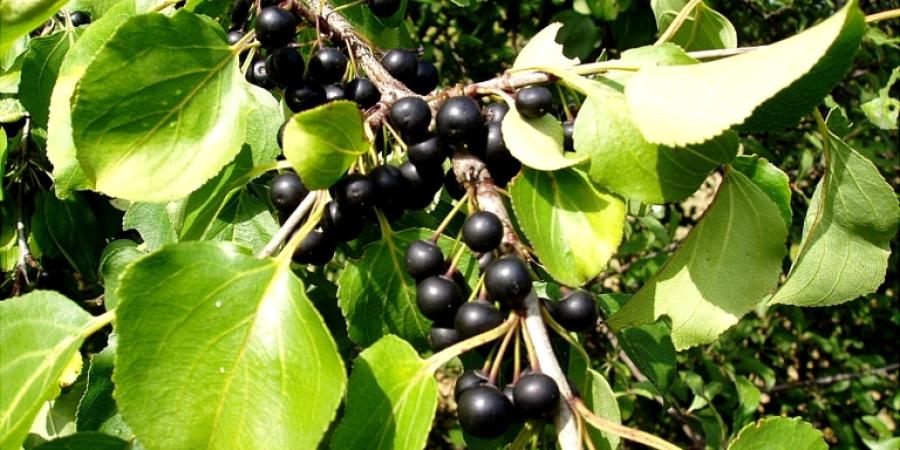As we were out conducting Stream Wise assessments for private landowners around the watershed and other field work this year, Ausable River Association staff continuously found three concerning invasive species: buckthorn, honeysuckle, and barberry. Our previous blog posts have gone over barberry and honeysuckle identification and management, but buckthorn deserves a blog of its own. This pesky terrestrial plant easily outcompetes natives and seems to quickly start sprouting everywhere. Pesky sure, but there are several ways to manage infestations on your property, and winter is a great time to do it.
What's so bad about buckthorn?
Unlike many invasive terrestrial plants, buckthorn does not need a disturbance in the soil to inhabit an area, only open spaces. Shrubs leaf out early and grow high in dense thickets, shading out other plants early in the growing season and discouraging native growth. Similar to invasive barberries and honeysuckles, buckthorn develops juicy berries that attract birds and other fauna, which greatly contributes to seed dispersal. Further, the berries regularly overwinter on the plants, so they are a popular food source for animals throughout much of the year. Once the seeds are deposited in the soil, they remain viable for up to six years. All of these factors make buckthorn highly competitive in ecosystems. Unfortunately, buckthorn berries have little nutritional value, and their presence has been shown to lower local soil and insect biodiversity.
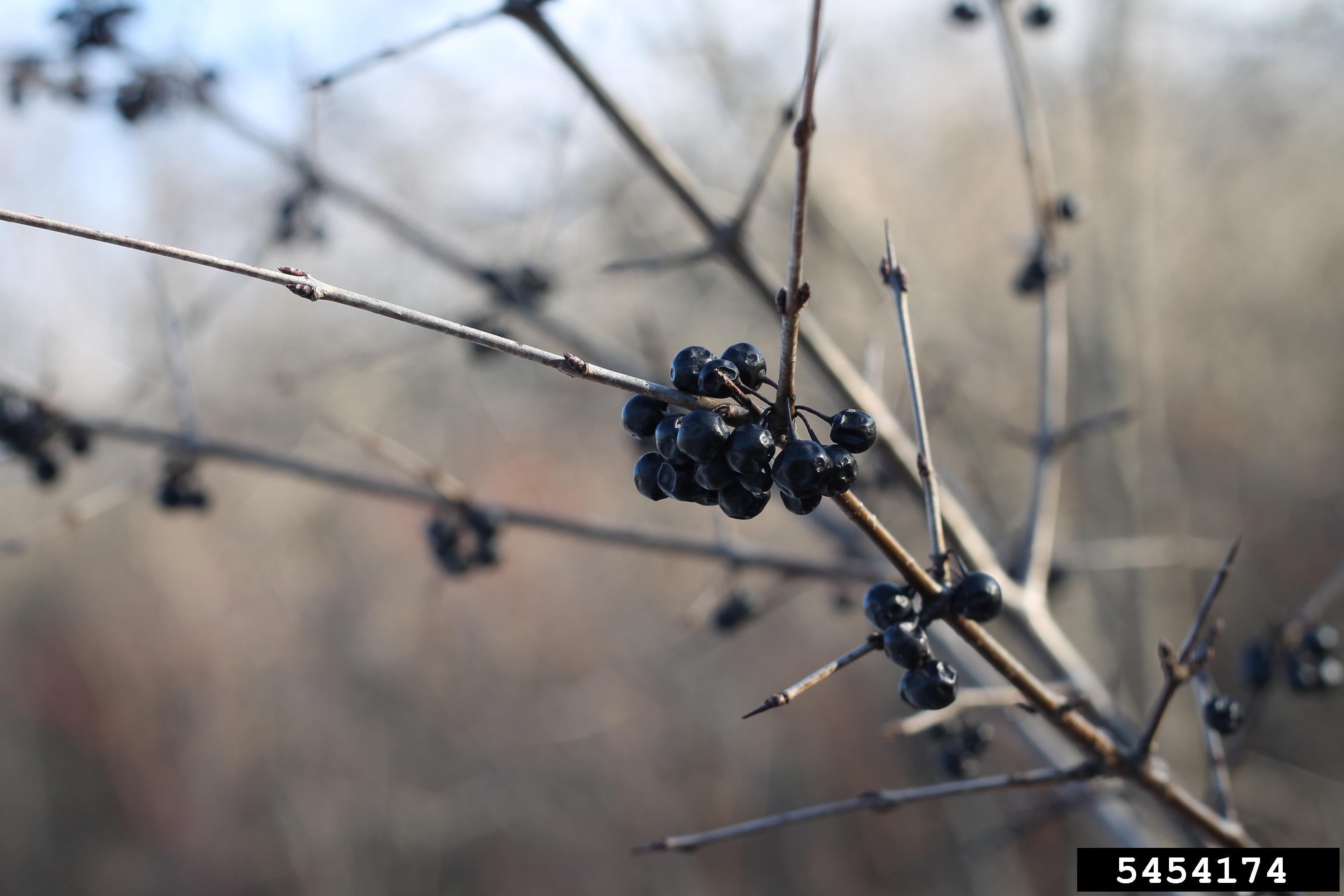
Even after its leaves fall, buckthorn berries remain a viable food source throughout the cold season. This leads to higher rates of seed dispersal and allows the shrub to spread rapidly. Photo credit: Rob Routledge, Sault College, Bugwood.org
Where is buckthorn a problem?
In the United States there are two types of invasive buckthorns, Rhamnus cathartica L., also known as common buckthorn, and Rhamnus frangula, or glossy buckthorn. Both plants are native to Europe and western Asia, and they were introduced to our continent over 200 years ago for ornamental use. Common and glossy buckthorn are each considered problematic throughout the entirety of the northern USA and southern Canada, but common buckthorn outbreaks are especially dense here in the northeast United States. According to iMapInvasives, common buckthorn is widespread in New York State, though much of the Adirondack region has been spared so far. Most of the reports of common buckthorn are concentrated on the edges of the park including many areas in the Champlain Valley and the Ausable Watershed. Glossy buckthorn is less of a threat to the Adirondacks and has only been officially reported in the Champlain Valley, although AsRA staff has positively identified it on a tributary to the Main Stem Ausable River during a Stream Wise survey in 2023.
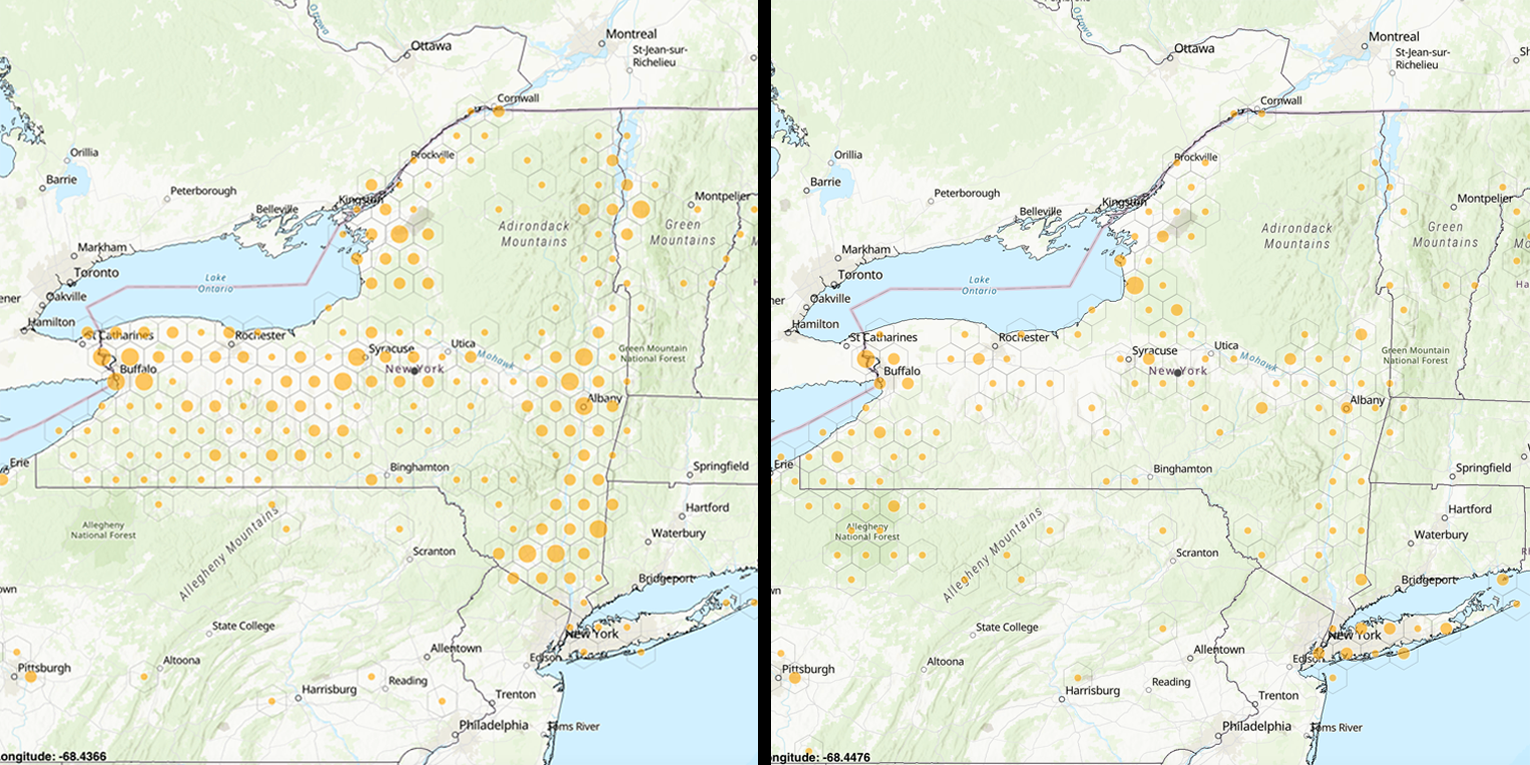
The maps above show relative numbers of common (left) and glossy (right) buckthorn plants reported in New York State and surrounding areas. So far, we have managed to prevent invasive buckthorns from dominating in the Adirondacks, but they are beginning to creep in along the edges and more highly trafficked areas of the park. Map source: iMapInvasives
Is there buckthorn on your property?
Invasive buckthorns are widely adapted, so they can grow in almost any deciduous ecosystem. They thrive in open spaces: they are often found on roadsides, property edges, and open areas of forests. Common buckthorn prefers dry sites, but glossy buckthorn is found in both wet and dry environments.
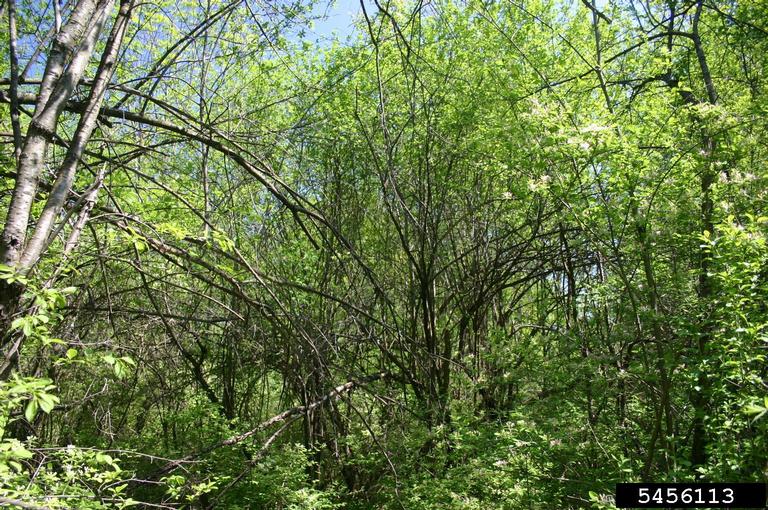
Buckthorn can behave both like a shrub and a tree. The tallest of these common buckthorn plants have been growing undisturbed for several years. Their bottom branches have grown tall like tree trunks but are individually only a few inches thick. Below, younger plants appear more shrub-like and grow densely to crowd out native species. Photo credit: Leslie J. Mehrhoff, University of Connecticut, Bugwood.org
Support our biodiverse habitats work for wildlife and their habitats. Give with confidence today!
Common and glossy buckthorn plants are quite similar in appearance. Both are technically deciduous shrubs but are often compared to trees because in just a few years, small shrubs can grow up to 30 feet tall and develop a trunk that measures almost a foot in diameter. Both shrubs have dark green, oval shaped leaves, but common buckthorn’s leaves are toothed, while glossy buckthorn’s are not. The shrubs develop small light green or white flowers early in the season that turn into green berries. Throughout the summer, the berries slowly ripen to a dark purple color, with glossy buckthorn berries transitioning through a deep red color in between. Despite the names, only common buckthorn has thorns, usually at the end of twigs and stems.
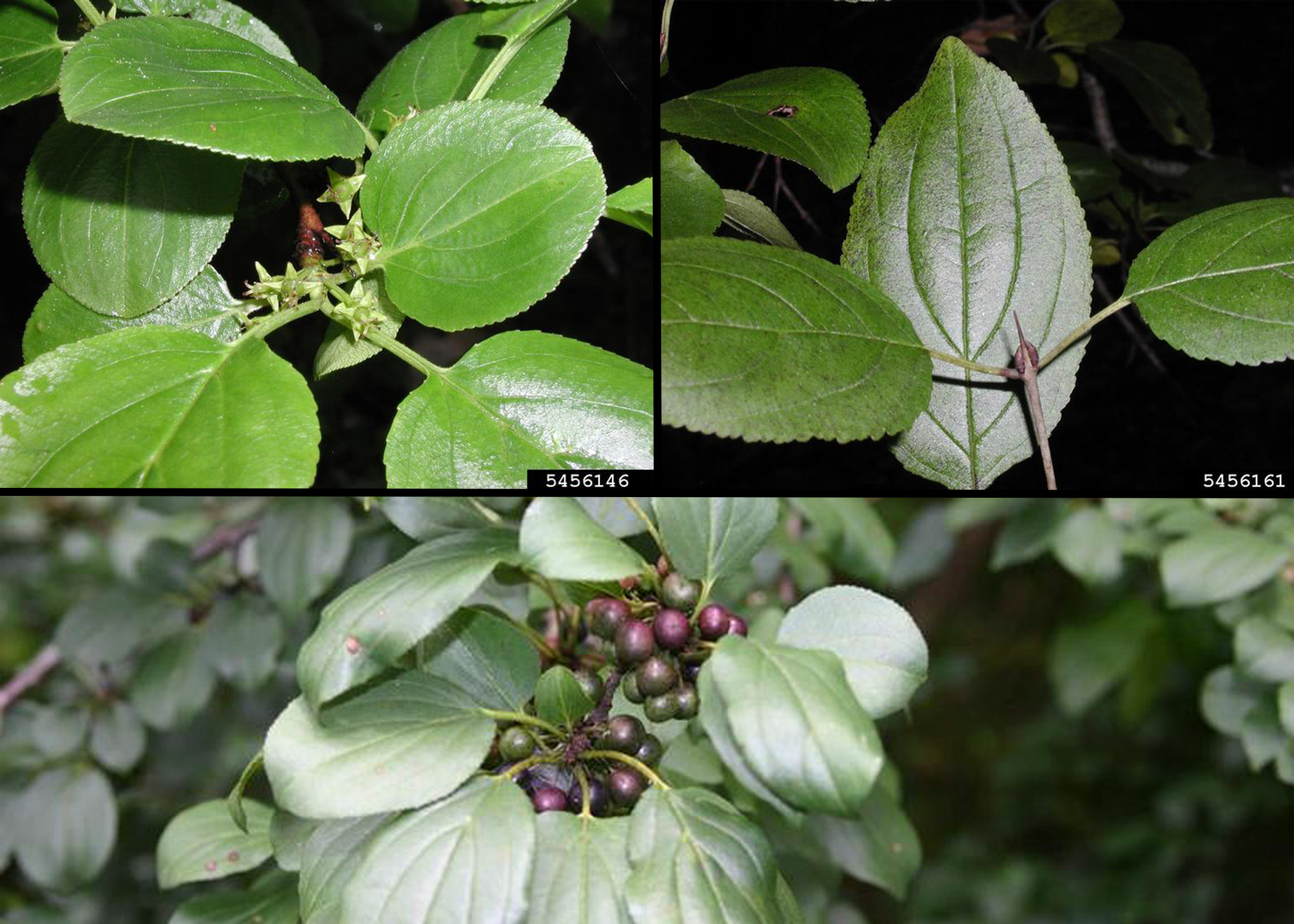
Leaves on common buckthorn have teeth, and the small flowers are light green or yellow. Its berries are green in the spring and slowly turn purple by the end of the summer. Thorns at the ends of branches and twigs are common. Photo credit: Leslie J. Mehrhoff, University of Connecticut, Bugwood.org
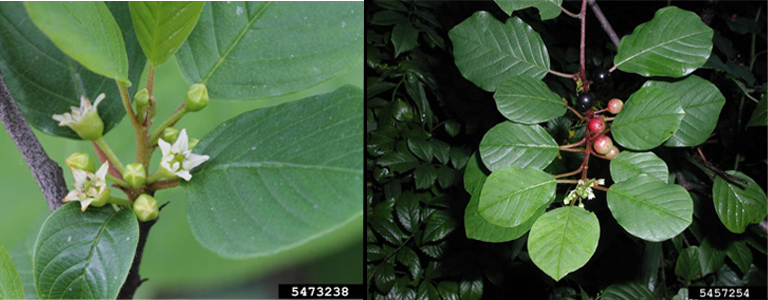
Glossy buckthorn has smooth, untoothed leaves that have more veins than common buckthorn. In the spring, it blooms with white flowers. The green berries turn red before becoming dark purple, when they become a popular food source for many animals. Photo credits: Rob Routledge, Sault College, Bugwood.org (left) and Leslie J. Mehrhoff, University of Connecticut, Bugwood.org (right)
Buckthorn is often confused with cherry trees. One way to distinguish between these species is to pull a twig off your tree. The inner wood of cherries appears pink or red, and buckthorn is brown or orange. Another easily confused similar species to look out for is the native alder leaf buckthorn Rhamnus alnifolia, which is a key component of North American ecosystems. This plant does not grow nearly as tall as its invasive counterparts; alder leaf buckthorn only reaches heights of about three feet at maturity. Its leaves have small teeth similar to common buckthorn, but it has flowers with five petals rather than four, it has small green appendages at the base of each leaf stem, it is thornless, and it likes to grow in wet areas like fens and wetlands.
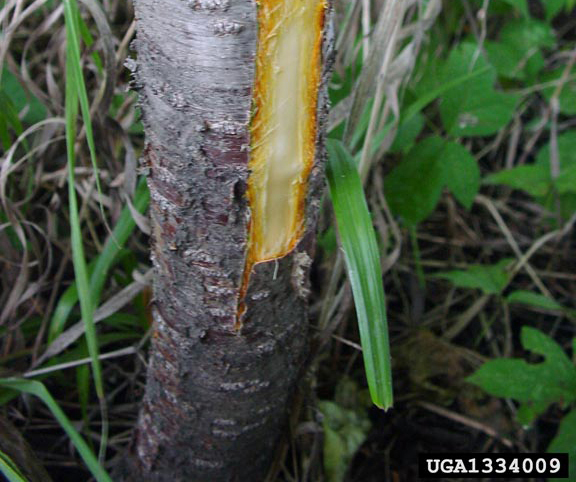
One way to distinguish between buckthorn and cherry trees is to pull a twig off your tree. The inner wood of cherries appears pink or red, and common buckthorn wood ranges from light brown to orange in color. Photo credit: Chris Evans, University of Illinois, Bugwood.org
How are invasive buckthorns best managed?
Mechanical, chemical, or a combination of methods may be most effective for treating your buckthorn invasion. Small plants should be removed as soon as possible before they begin to seed. If the plant is established, cutting prior to flower development is optimal to minimize spread. Repeated cutting will be necessary but will discourage plant growth over time. When the shrub can’t be completely removed, it can be covered with a dark black plastic bag.
Foliar herbicides can be used on buckthorn during its active growth, but effects on the surrounding ecosystem, such as proximity to waterways and potential for erosion, should be taken into account. Herbicides can also be injected directly into a stump to prevent regrowth and minimize effects on nontarget organisms.
Cold weather control involves managing plants between November and February. Both mechanical and chemical methods described above have been highly effective at eliminating buckthorn when performed during these months and, in the case of chemical methods, greatly reduces the negative impact on surrounding plants.
If possible, it is best to burn downed plants on site, otherwise they can be put into black plastic bags and left out in the sun. Once you get rid of the buckthorn, make sure to plant something native in its place to keep it away for good.
It may be worthwhile to consider cold weather buckthorn control as your outdoor project for this winter, or maybe tackle it early next spring and have a celebratory end-of-winter buckthorn bonfire! No matter how you go about it, getting rid of buckthorn as soon as possible will benefit your property and improve the health of the wilderness around you.
If you’d like more information, or if you are interested in attending an event about buckthorn identification and removal, please contact us. If you’re not sure whether this species is present on your river or stream side property, consider signing up for a Stream Wise assessment next year. Thank you for stewarding the Ausable River watershed!
Story by Krista, 2023 River Steward. Top Photo Credit: Jan Samanek, Phytosanitary Administration, Bugwood.org.
Sign-up for our e-newsletter to get weekly updates on the latest stories from the Ausable River Association.
